400 Legend Ballistics From The Leading Ammunition Manufacturer
Winchester’s new 400 Legend is an appealing rifle cartridge because sportsmen can use it to take whitetail, black bear, and other medium game in Indiana, Michigan, Ohio, and other states which prohibit bottleneck rounds for hunting.
This new straight-walled cartridge does have its limitations, though. Scroll through the spec charts below to better understand 400 Legend ballistics, its effective range, and how various bullets perform at the shooting range and in the field.
400 Legend Ballistics Charts
Winchester Ammunition Ballistics Chart - 400 Legend
Winchester Power Point 400 Legend 215 grain PSP Ballistics Chart
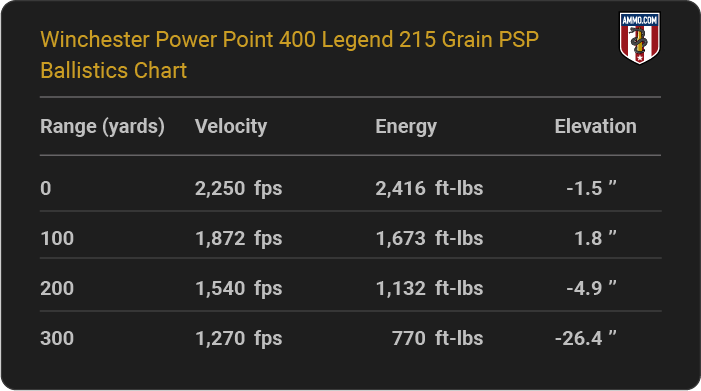
Winchester Super Suppressed 400 Legend 300 grain Open Tip Ballistics Chart
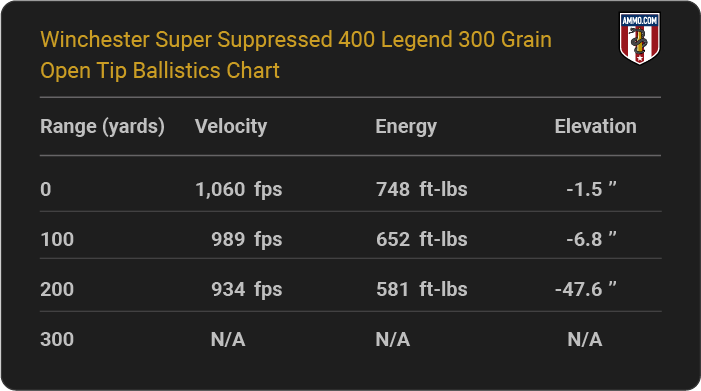
Administrative Note: The information above comes from the manufacturer and is only intended to provide an impression of the cartridges’ actual performance. The actual ballistics obtained with your firearm can vary considerably from the advertised ballistics. Also, ballistics can vary from lot to lot with the same brand and type load. When manufacturer ballistic data were unavailable, ballistics were calculated using a ballistics calculator.
400 Legend Ballistics Trajectory Chart
A bullet’s trajectory is also known as its flight path to the target. Sport shooters often measure the bullet’s elevation in inches of bullet drop, but it can also be measured in minutes of angle (MOA).
A flatter trajectory is preferred for long-range shooting because it requires the shooter to make fewer adjustments to compensate for bullet drop. Bottleneck cartridges like the 308 Winchester and 6.5 Creedmoor provide excellent examples of flat trajectories, which is why they’re so popular among long-range shooting enthusiasts.
The 400 Legend was intended for short-range hunting applications in thick brush. Its long-range trajectory is accordingly nothing to be excited about. It is relatively flat-shooting out to 200 yards. After that, it begins to drop quickly.
Below is a sample 400 Legend bullet drop chart that provides a general idea of the 400 Legend trajectory.
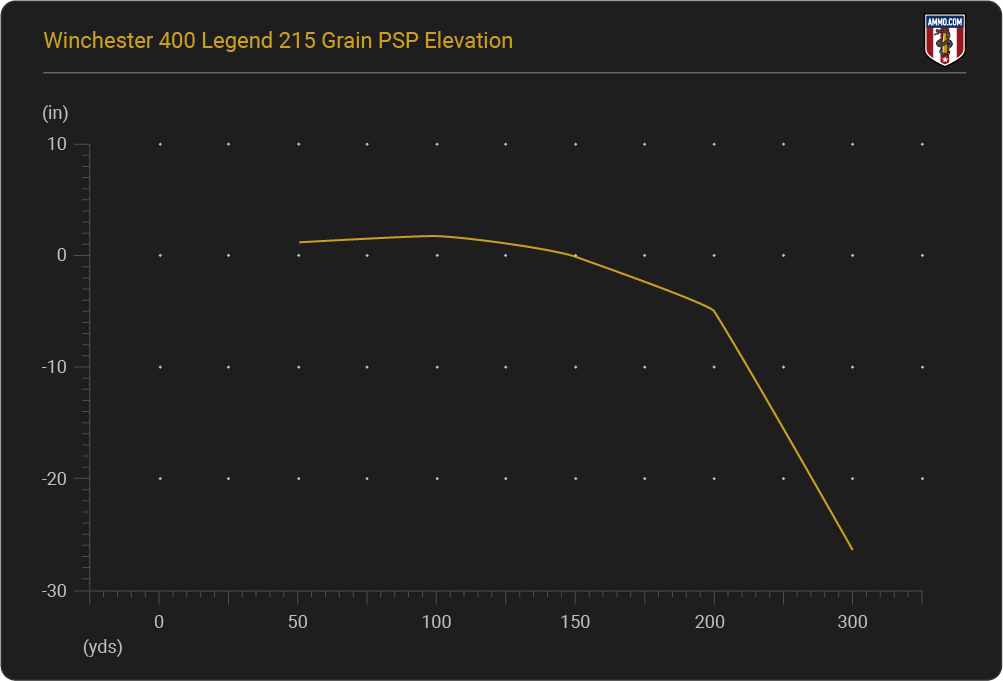
Note: The above chart illustrates only one 400 Legend load's performance. Actual ballistic performance varies depending on bullet weight, lot, barrel length, and environmental conditions while shooting.
400 Legend Velocity
The rate at which the bullet exits the rifle barrel is the muzzle velocity, measured in feet per second (fps).
A longer barrel length generally produces a higher muzzle velocity, as it gives the propellant gasses more time to exert their energy against the base of the projectile. A bolt-action rifle with a 22” barrel will produce higher velocities than a carbine with a 16” barrel, even though you’re firing the same 400 Legend ammo.
Its design and weight also play significant roles in how much velocity a projectile will exhibit at any point downrange. For example, polymer-tipped hollow point boat tail projectiles conserve velocity more efficiently than traditional soft point bullets, and heavier bullets tend to have lower muzzle velocities than lighter ones.
Handloads also tend to have higher velocities than factory-loaded 400 Legend ammunition. This is just one reason why reloading is so popular among competitive shooters and serious hunters.
The muzzle velocity of factory 400 Legend ammo normally ranges from 1,000 fps to 2,250 fps.
400 Legend Kinetic Energy
A bullet’s kinetic energy is measured in foot-pounds (ft-lbs). Muzzle energy reflects the force with which a bullet leaves the barrel. Heavier bullets tend to have higher muzzle energy, although velocity is a significant factor.
According to Savage Arms, “Winchester Repeating Arms claims the 400 Legend has the energy equivalent to the .450 Bushmaster but with 20% less recoil.”
The Winchester Power-Point 215 grain soft point bullet has a muzzle energy of 2,416 ft-lbs. At 200 yards downrange, its kinetic energy has dropped to 1,132 ft-lbs.
400 Legend Effective Range
Like other straight wall cartridges, the 400 Legend cartridge offers a limited range for deer hunting.
Three hundred yards is about the maximum effective range for the 400 Legend in the hands of an average shooter. Highly skilled shooters might be able to push that distance out to 350-400 yards, on a good day.
How Do 400 Legend Ballistics Compare to Other Rifles?
Have you ever wondered how the 400 Legend stacks up against other hunting cartridges like the 360 Buckhammer, 12 Gauge slug, 350 Legend, or 450 Bushmaster? In some instances it has less recoil, better knockdown power, and greater penetration – but is it better than what you’re currently hunting with?
Let’s find out below.
400 Legend vs. 350 Legend Ballistics Chart
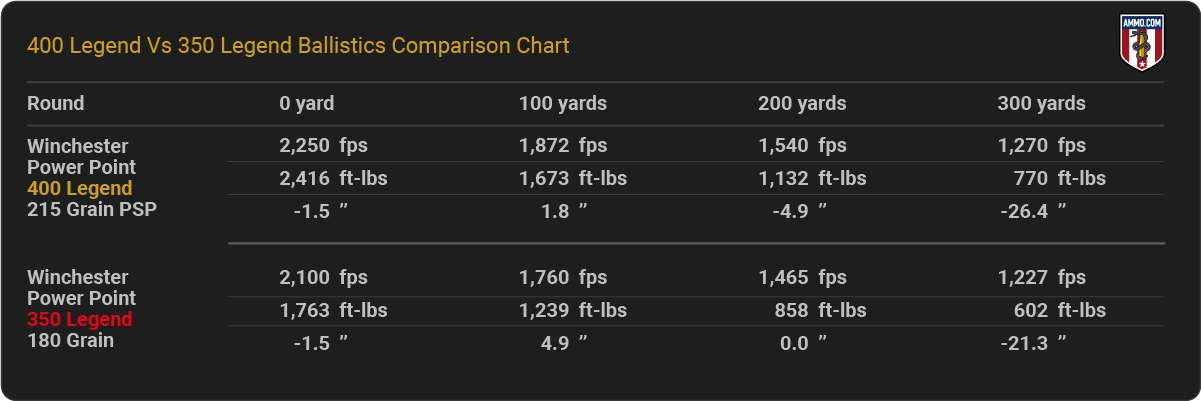
Don’t miss our deep dive into 350 Legend ballistics for an in-depth look at the 350 Legend.
400 Legend vs. 450 Bushmaster Ballistics Chart
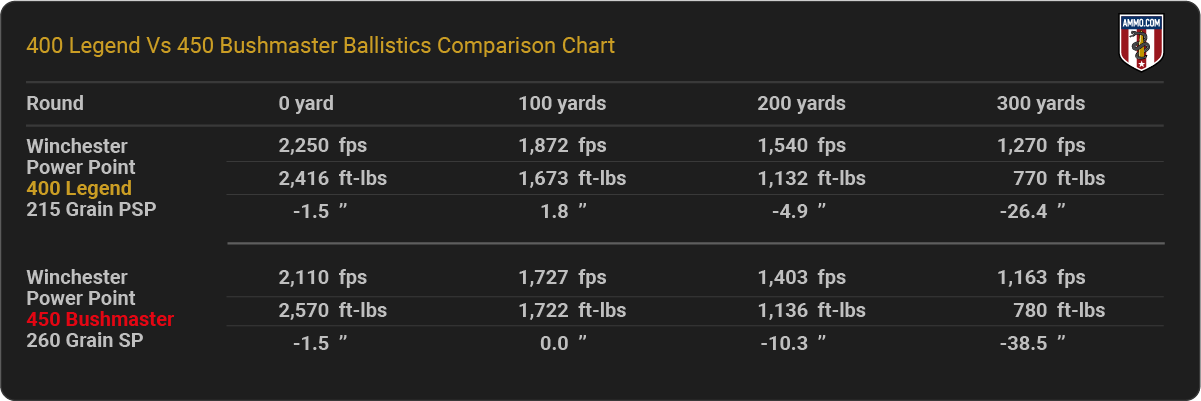
Frequently Asked Questions
The team at Ammo.com has gathered and answered some of the most commonly asked questions regarding 400 Legend ballistics.
What is the effective range of a 400 Legend?
The effective range of a 400 Legend cartridge is 300 yards.
What is the 400 Legend equivalent to?
The 400 Legend is equivalent to the 450 Bushmaster in terms of energy.
What is the difference between Winchester 400 Legend and 350 Legend?
The 400 Legend has more range, is loaded with heavier bullets, and offers hunters 25% more energy and greater penetration than the 350 Legend.
Ballistic Charts
- 308 Ballistics Charts
- 6mm ARC Ballistic Charts
- 10mm Auto Ballistics Charts
- 224 Valkyrie Ballistics Charts
- 204 Ruger Ballistics Charts
- 30-30 Ballistics Charts
- 6.8 SPC Ballistics Charts
- 350 Legend Ballistics Charts
- 300 Blackout Ballistics Charts
- FN 5.7x28 Ballistic Charts
- 7.62x39 Ballistics Charts
- 22 Creedmoor Ballistics Charts
- 300 PRC Ballistics Charts
- .360 Buckhammer Ballistics Charts
- 8.6 Blackout Ballistics Charts
- 30-06 Ballistics Charts
- 44 Magnum Ballistics Charts
- 7mm-08 Ballistics Charts
- 7mm Rem Mag Ballistics Charts
- 300 Win Mag Ballistics Charts
- 270 Win Ballistics Charts
- 45 Long Colt Ballistics Charts
- 6.5 Creedmoor Ballistics Charts
- 40 S&W Ballistics Charts
- 243 Win Ballistics Charts
- 357 Magnum Ballistics Charts
- 380 ACP Ballistics Charts
- 45 ACP Ballistics Charts
- 223 Rem Ballistics Charts
- 450 Bushmaster Ballistics Charts
- 400 Legend Ballistics Charts
- 5.56 Ballistics Charts
- 9mm Ballistics Charts
- 28 Nosler Ballistics Charts
- 45-70 Ballistics Charts
- 6.5 PRC Ballistics Charts
- 22-250 Ballistics Charts
- 22 Hornet Ballistics Charts
- 7mm PRC Ballistics Charts
- 22 ARC Ballistics Charts
- 6.8 Western Ballistics Charts
